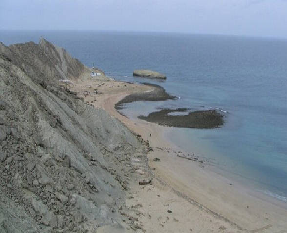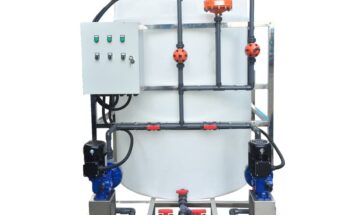Astola Island also known as Haft Talar (meaning – seven rocks) is an uninhabited island, present in the Arabian Sea south of Pasni at 25o7′ and 63o52’E. It is 4 km long, 0.6 km wide and is a part of Pasni sub-division Gawadar District. Astola Island was declared as a Ramsar site on 10th May 2001. Astola Island is under the ownership of Balochistan Revenue Department. Fisheries Department is only responsible for management activity within 12 Nautical Miles. As Astola Island is present in the contiguous zone that is up to 24 Nautical Miles thus its management is under Maritime Security Agency. They are responsible for managing any illegal activity (including illegal fishing and coral mining) in the area.
The climate featured through out the year is relatively milder; winter month’s temperature varies between 20ºC to 25ºC.
The island is comprised of a sand rocky beach and a cliff with plain area on its top. The south face of Astola Island has various caves.
Fishermen from Sindh (Sindhi and Bangali) and Balochistan (Balooch) come to this area throughout the year from August to May mostly they stay for a week or ten days in their boats. Few of them come to Astola for up to a month. They live on the coast of the island where 2 huts have been made of wood. These huts when damaged are either reconstructed or repaired by the fishermen visiting the area. Fishermen use fishing rod, ring net, net and gun for fishing activity.
Population: From August to May at a time there are around 60 fish anglers in 10 to 15 boats fishing in the area.
Occupation: The major occupation is fishing (fish, crabs and lobsters), however some fishermen are also engaged in shell collection and coral mining activity.
Income: The average net monthly income of a boat is Rs 69,556. This income is divided amongst fishermen on the basis of Patti System. On the average in a month a Khalasi (fish labourer) coming to Astola Island earns Rs 6,956.
Rocky, sandy area with cliffs and barren land.
Launaea procumbens, Maerua arenaria, Cadaba heterophylla, Haloxylon stocksii, Cenchrus penesitiformis, Commicarpus boiserii, Abutilon fruticosum, Pentatropis, Medicago lupalinea, Sonchus asper.
The major habitats types were calcarious plan on the top of the island, slopes, shoreline
It was amazingly diversified habitat were dense patches of vegetation was observed in depressed areas. The species noted here was Convolvulus glomeratus, Convolvulus prostratus, Launaea procumbens, Maerua arenaria, Cadaba heterophylla, Haloxylon stocksii, Cenchrus penesitiformis, Commicarpus boiserii, Abutilon fruticosum, Pentatropis, Medicago lupalinea, Sonchus asper,
That was about 95% barren very few species like Maerua arenaria, Sporobolus kentrophyllus, atriplex stocksii, Inual grantioides, was noted wich was very sparsly found.
The shoreline consist of Suaeda fruticosa, Cistanche tubulosa, Haloxylon stocksii, Zaelya pentandra, Azoon canarensis, Heliotropium crispum, Lotus sp, Zygophyllum propenquum, and Prosopis juliflora.
More than 20 species of birds are in record from various studies at this particular area. The summer/winter migratory birds create a striking setting to view the marvellous diversity. Some of the abundant species are Great Egret, Grey Heron, Osprey, Common Kestrel, Lesser Crested Tern, Sooty Gull, Yellow-legged Gull, Crested Lark, Spanish Sparrow, Desert Wheatear and Black Redstart of which Great Egret, Grey Heron, Common Kestrel and Crested Larks are resident, Osprey, Yellow-legged Gull, Spanish Sparrow, Black Redstart and Desert Wheatears are winter visitor, Sooty Gulls are summer visitors and Lesser Crested Tern are Passage migrant and irregular year round visitor in the area.
During survey more than 30 fish species noted.
The terrestrial larger mammals are absent on the Island, but the waters hold a marine cetacean species of: Finless porpoise (Neophocaena phocaenoides).
The enduring rodents capable to maneuver in the difficult terrains of this remote island are 2 species of: House mouse (Mus musculus) and House rat (Rattus rattus). House rats feast on the eggs laid by the green turtles during their particular season
Astola Island sustains 8 species of herpetic fauna, specified as; 2 turtles kinds are; Green turtle (Chelonia mydas) and Olive Ridley (), 4 lizards and 3 snakes: 2 are sea snakes; Banded small-head sea snake (Microcephalophis gracilis), Spotted small-head sea snake (Coluber lacteus) and a terrestrial winder; Saw scale viper (Echis carinatus astolae) which is also an endemic species to the Astola Island.
The main drawers of organic assets are:
Fishermen that live on the coast for a month or so collect branches of shrubs and bushes to use as fuelwood for cooking and heating purpose and their average annual fuelwood consumption is about 714 kg.
5.0 Major Issues and Threats
Fishermen stay in the waters of the island for a few days and dump damaged nets and other types of non degradable waste on its coast. Further they are not aware of sustainable fishing practices. Some fishermen are also engaged in coral mining and shell collection activity. Corals are also damaged by ghost nets (nets that get trapped in corrals). Apart from illegal fishing and coral mining, marine life is also being adversely affected by oil being spilt in the sea by trawlers. Big fish trawlers dump their crude oil bars in the sea. Another source of small amount of oil spill in the sea is during exchange of illegally smuggled oil from one boat to another in an inappropriate way.
6.0 Recommendations
- Need to declare it as a marine protected area as it is very rich in biodiversity including the Corel Reefs.
- Need to educate the fisherman community about importance of this island and their resources.





